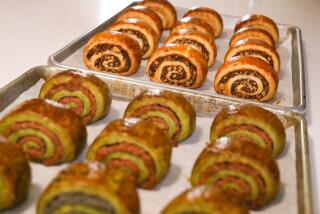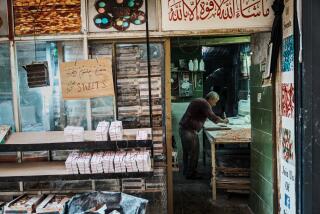A Treat for the Sultan
- Share via
The world has forgotten about lauzi^naj, but for centuries it was a gourmet passion in the Middle East--the pinnacle of gastronomic delight. It consisted of rose-scented almond paste wrapped in a paper-thin crepe; often it was stored in almond oil (this was known as “drowned” lauzi^naj).
It had been considered the ideal pastry at the 6th century Persian court, the only sweet suitable for eating at all seasons. After the Muslims conquered Iran, lauzi^naj conquered the Muslims. The poets of Baghdad sang its praises, comparing its paper-thin pastry to the delicate wings of grasshoppers.
In a 10th century tale about a Baghdad city slicker conning a free lunch out of a rube, the con man observes that lauzi^naj just “slips into the veins.” He demands the very finest from a pastry shop: “Let it be but one night old, on sale just this morning, the crust paper-thin, generously filled, pearled with almond oil, starry in color, melting before it meets the teeth.”
When it comes to their favorite dishes, gourmets can lose their perspective. The sophisticates of Baghdad assumed that lauzi^naj would have to impress Toghril Beg, the 11th century Turkish conqueror who finally ended the power of Baghdad’s caliphs (he was the first ruler to call himself a sultan). But when someone handed the rough nomad warrior a sample, his only comment was, “This are pretty good noodles, but they need garlic.”
More to Read
Eat your way across L.A.
Get our weekly Tasting Notes newsletter for reviews, news and more.
You may occasionally receive promotional content from the Los Angeles Times.
![LOS ANGELES, CA - JUNE 17: [Cody Ma and Misha Sesar share a few dishes from their Persian Restaurant Azizam] on Monday, June 17, 2024 in Los Angeles, CA. (Ethan Benavidez / For The Times)](https://ca-times.brightspotcdn.com/dims4/default/7ffc7f6/2147483647/strip/true/crop/5110x3417+306+0/resize/320x214!/quality/75/?url=https%3A%2F%2Fcalifornia-times-brightspot.s3.amazonaws.com%2F79%2Fdc%2F4d29255545f5b9813315901692bc%2F1459972-fo-azizam-review20-eba.JPG)









